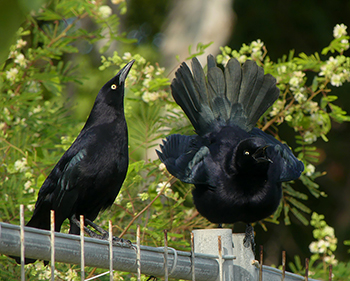Impress, dance, the most beautiful colors and feathers. It takes quite a bit of work for a male bird to seduce a female. With one species it is even more complicated than the other, as evidenced by the latest documentary on Netflix called ‘Dancing with the Birds’. A real must for those who like to be amazed by the enormous behavioral diversity of animals.
On the ABC islands, various bird species have a whole ritual to conquer a partner. With the White-tipped Dove pigeon for example or the Ala duru, the males dance for the female and if she agrees to the match, she joins in the dance. Male hummingbirds make flights through the sunlight to show the female how beautifully their feathers shine in the light.
The troupial puts up his throat and head feathers and sings the highest song while moving a bit crazy. A Bananaquit even has to show his building skills after conquering the attention of the female before its fate is really decided. If the future mother rejects the nest, it is completely demolished and the male has to start over.
The Carib grackle (Quiscalus lugubris), the black birds with a purple sheen on their feathers and pure white eyes, not only compete for the favors of the much browner female, but also have to outwit potential competitors before the female even gives him a glance. And so you can occasionally observe the behavior of two adult males with their beautiful tails competing against each other in a competition where they alternately lower their ankles, spread their tails and let out a beautiful tune. And only when they agree among themselves who is the strongest and has the best chance with the female, can the conquering of the lady begin. And that does not happen without a fight. Because although they may have come to an agreement as males who is the best, that does not mean that the female agrees.
English name: Carib Grackle
Papiamentu name: Zenata karibeño
Scientific name: Quiscalus lugubri
Occurrence (ABC islands): Aruba, Bonaire and Curaçao

Een gooi om haar gunsten

Foto: Michelle Pors-da Costa Gomez
Imponeren, dansen, de mooiste kleuren en veren tooien. Er is nogal wat voor nodig als mannelijke vogel om een vrouwtje te versieren. Bij de ene soort gaat het er nog ingewikkelder aan toe dan de andere, getuige de laatste documentaire die op Netflix te zien is met de naam ‘Dancing with the Birds’. Een echte aanrader voor wie zich graag laat verbazen over de enorme gedragsdiversiteit van dieren.
Ook op Curaçao kennen verschillende vogelsoorten een heel ritueel om een partner te veroveren. Bij de Verreaux duif bijvoorbeeld of de Ala duru, dansen de mannen voor het vrouwtje en als ze akkoord gaat met de match gaat ze mee in de dans. Mannetjes kolibries maken vluchten door het zonlicht om het vrouwtje te laten zien hoe prachtig zijn veren schitteren in het licht.
De trupiaal zet zijn keel en kopveren op en zingt het hoogste lied onderwijl een beetje maf bewegend. Een Suikerdiefje moet na het veroveren van de aandacht van het wijfje zelfs eerst zijn bouwkunsten laten zien voor het echt beslecht is. Als de toekomstige moeder het nest afkeurt wordt het helemaal gesloopt en mag de heer opnieuw beginnen.
De Caribische troepiaal of Carib grackle (Quiscalus lugubris), de zwarte vogels met paarsachtige glans op de veren en spierwitte ogen, dingt niet alleen naar de gunsten van het veel bruinere vrouwtje, maar moet ook potentiële concurrenten af troeven voordat het vrouwtje hem überhaupt maar een blik waardig gunt. En zo kun je dus af en toe het gedrag observeren dat 2 volwassen mannen met hun prachtige staart tegen elkaar opgaan in een concurrentiestrijd waarbij ze om en om door de enkels zakken, de staart spreiden en een prachtig riedeltje laten horen. En pas als ze onderling het eens zijn wie de sterkste is en de beste kans heeft bij het vrouwtje, kan het veroveren van de dame beginnen. En dat gaat ook niet zonder slag of stoot. Want ze mogen er dan gezamenlijk als mannen uitgekomen zijn wie de beste is, dat wil niet zeggen dat de dame het daarmee eens is.
Nederlandse naam: Caribische troepiaal
Papiamentse naam: Zenata karibeño
Wetenschappelijke naam: Quiscalus lugubris
Voorkomen (ABC eilanden): Aruba, Bonaire en Curaçao